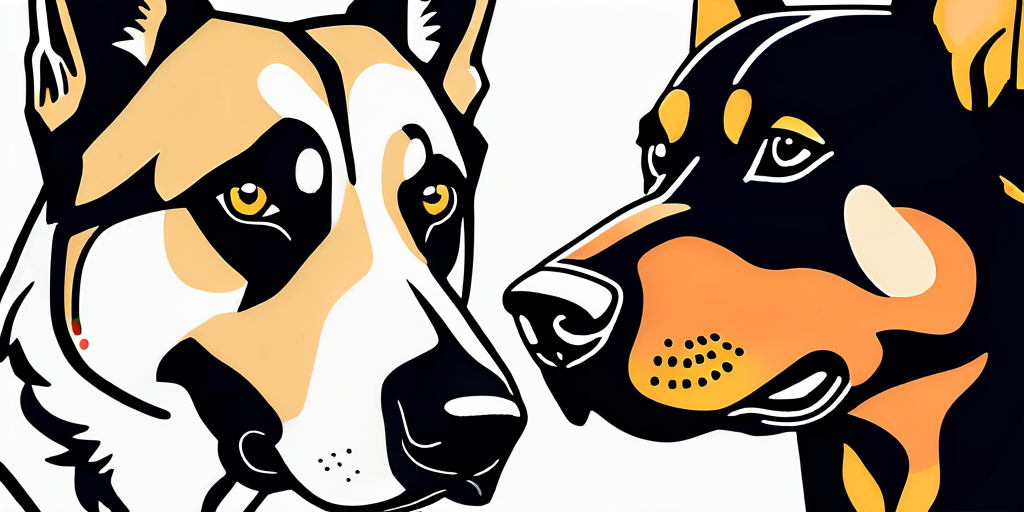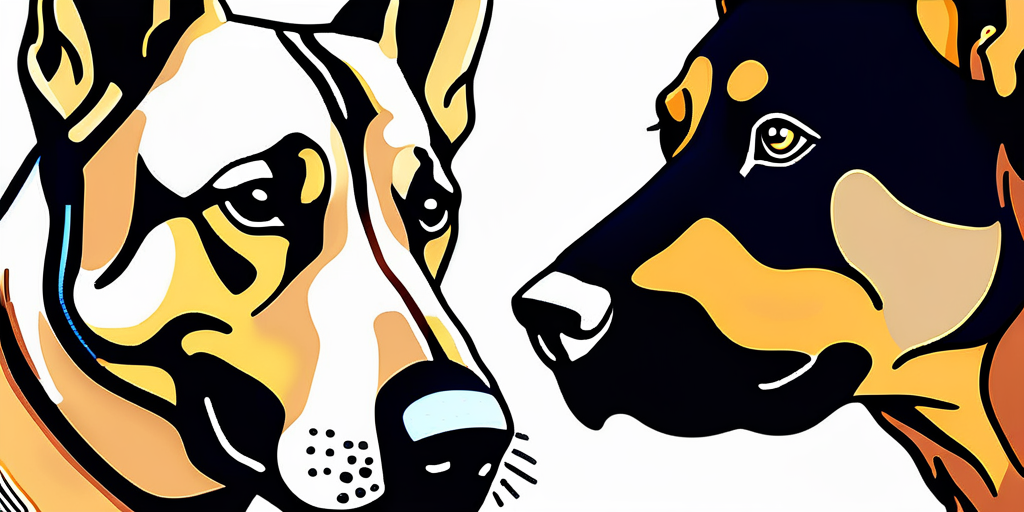Deciding which dog breed is the right fit for you and your family is an important decision. Two popular and well-known breeds that often come up in this discussion are the German Shepherd and the Rottweiler. Both breeds have distinct characteristics, temperaments, and maintenance needs that should be considered before making a decision. In this article, we will delve into the key differences between these two breeds to help you make an informed choice.
Understanding the Breeds
Before diving into the specifics of each breed, it is important to have a general understanding of the German Shepherd and the Rottweiler.
German Shepherds and Rottweilers are both breeds that have made significant contributions to various fields due to their unique characteristics and abilities. Let’s delve deeper into what makes these two breeds stand out among the canine world.
Key Characteristics of German Shepherds
German Shepherds are a large and muscular breed with a noble and confident appearance. They are highly intelligent and have a strong work ethic, which makes them excellent working dogs. German Shepherds are known for their loyalty, protectiveness, and versatility. They excel in various roles, including as family pets, service dogs, and police dogs.
Originating from Germany, German Shepherds were initially bred for herding sheep. Over time, their intelligence and trainability led them to become one of the most versatile breeds, excelling in obedience, agility, search and rescue, and even as therapy dogs. Their keen sense of smell and unwavering loyalty make them a popular choice for various working roles.
Key Characteristics of Rottweilers
Rottweilers are also a large and powerful breed with a robust and sturdy build. They have a calm and confident temperament and are highly protective of their families. Rottweilers have a strong desire to please their owners and can be trained for various tasks. They are known for their loyalty and are often used as guard dogs or working dogs in roles such as search and rescue.
Originally hailing from Rottweil, a town in Germany, Rottweilers were bred as herding and guarding dogs. Their muscular build and confident demeanor make them excellent protectors, while their intelligence and eagerness to work make them versatile in tasks such as obedience, tracking, and even as therapy dogs. Despite their strong appearance, Rottweilers are known to be affectionate and loyal companions to their families.
Temperament and Personality Traits
The temperament and personality traits of a dog breed play a significant role in determining their compatibility with different households and lifestyles. Understanding these characteristics can help potential dog owners make informed decisions when choosing a furry companion.

When considering a dog breed, it’s essential to look beyond just their physical appearance and consider their behavioral tendencies and instincts. Each breed has unique traits that have been developed through years of selective breeding for specific purposes.
German Shepherd Temperament
German Shepherds are known for their loyalty and devotion to their families. They are highly trainable and eager to please, making them suitable for households that are willing to invest time and effort into training and socialization. Their intelligence and versatility have made them valuable working dogs in various fields, including search and rescue, police work, and as service animals for individuals with disabilities. German Shepherds thrive on mental and physical stimulation and require regular exercise to prevent boredom and behavioral issues.
Rottweiler Temperament
Rottweilers are also highly loyal and protective of their families. They are confident, calm, and often reserved with strangers. Historically, Rottweilers were used as herding and guard dogs, showcasing their natural instincts to protect and serve their human companions. Despite their imposing size and strength, Rottweilers can be affectionate and gentle with their family members, especially when raised in a loving and structured environment. It’s important for Rottweiler owners to establish themselves as strong leaders through consistent training and positive reinforcement techniques to ensure a well-behaved and balanced dog.
Training and Exercise Needs
The training and exercise needs of a dog breed will determine the amount of time and effort required to keep them happy, healthy, and well-behaved. Understanding these needs is crucial for providing the best care and environment for your furry companion.
When considering the training and exercise requirements of a dog, it’s essential to take into account their breed characteristics, energy levels, and intelligence. Each breed has unique traits that influence how they learn and respond to training, making it important to tailor your approach to suit their specific needs.
Training a German Shepherd
German Shepherds are highly trainable and intelligent, known for their loyalty and versatility in various roles such as police work, search and rescue, and service assistance. Their keen intelligence and eagerness to work make them quick learners, but they require consistent and positive reinforcement training methods to thrive. German Shepherds excel in structured environments and benefit from obedience training to establish boundaries and expectations. Mental stimulation, such as puzzle toys and interactive games, is also essential to keep their minds engaged and prevent boredom.
In addition to mental challenges, German Shepherds require plenty of physical exercise to maintain their physical health and prevent behavioral issues. Long walks, runs, and play sessions are vital to channel their energy in a positive way and prevent destructive behaviors that may arise from pent-up energy.
Training a Rottweiler
Rottweilers are intelligent and eager to please, making them relatively easier to train than some other breeds. With a history as herding and guarding dogs, Rottweilers are known for their strength, confidence, and protective nature. Consistent training and socialization from an early age are crucial to help them develop into well-rounded and well-behaved companions. Rottweilers benefit from mental stimulation to prevent boredom and engage their sharp minds. Training sessions that incorporate problem-solving tasks and new challenges can help keep them mentally sharp and focused.
Regular physical exercise is also essential for Rottweilers to maintain their muscle tone and overall health. Engaging in activities such as agility training, fetch, and interactive play sessions can help them burn off excess energy and stay physically fit. Providing both mental and physical stimulation is key to ensuring that Rottweilers remain happy, healthy, and well-behaved members of the family.
Health and Lifespan Considerations
Understanding the potential health issues that a breed may be prone to can help you make an informed decision about their long-term care needs.

When it comes to considering the health and lifespan of a specific breed, it’s important to delve deeper into the common ailments they may face throughout their lives. By being aware of these potential health issues, you can be better prepared to provide the necessary care and support for your furry companion.
Health Issues in German Shepherds
German Shepherds are known to be prone to certain health conditions that can impact their quality of life. These include hip and elbow dysplasia, degenerative myelopathy, and gastric dilatation-volvulus (bloat). These health concerns can be managed through regular veterinary check-ups, a balanced diet tailored to their specific needs, and consistent exercise to maintain their muscle strength and overall well-being.
Additionally, it’s crucial for German Shepherd owners to be vigilant about any changes in their pet’s behavior or physical condition, as early detection of health issues can significantly improve treatment outcomes and prognosis. By fostering a proactive approach to your German Shepherd’s healthcare, you can help them lead a long and healthy life by your side.
Health Issues in Rottweilers
Rottweilers, like many other breeds, have their own set of health challenges that owners should be aware of. These can include hip and elbow dysplasia, heart conditions, and certain types of cancer that may affect their well-being. To mitigate the risks associated with these health issues, it is important to prioritize regular exercise to maintain their muscle tone, provide a balanced and nutritious diet to support their overall health, and schedule routine veterinary check-ups to monitor any potential health concerns.
By fostering a strong partnership with your veterinarian and staying proactive in your Rottweiler’s healthcare, you can promote a healthy and fulfilling life for your beloved pet. Being attuned to their individual needs and addressing any health issues promptly can make a significant difference in enhancing their quality of life and ensuring they remain a cherished member of your family for years to come.
Maintenance and Grooming
The level of maintenance and grooming required by a breed is an important consideration, especially for individuals with allergies or those who prefer a low-maintenance pet.
When it comes to grooming needs, German Shepherds and Rottweilers have distinct characteristics that require specific care and attention. German Shepherds, known for their thick double coat, demand regular brushing to minimize shedding and maintain coat health. This breed typically sheds moderately year-round, with heavier shedding occurring during certain seasons. In addition to brushing, regular grooming practices such as nail trims and ear cleaning are essential to keep German Shepherds clean and healthy.
Rottweilers, on the other hand, boast a short and dense coat that is relatively low-maintenance compared to German Shepherds. While they also shed moderately throughout the year, regular brushing is still necessary to remove loose hair and promote a healthy coat. Similar to German Shepherds, Rottweilers benefit from routine grooming habits including nail trims and dental care to ensure their overall well-being.
Grooming Needs of German Shepherds
German Shepherds have a thick double coat that requires regular brushing to minimize shedding and maintain coat health. They typically shed moderately year-round, with heavier shedding occurring during certain seasons. Regular grooming, including nail trims and ear cleaning, is also necessary to keep them clean and healthy.
Grooming Needs of Rottweilers
Rottweilers have a short and dense coat that is relatively low-maintenance. They shed moderately throughout the year and benefit from regular brushing to remove loose hair. Routine grooming practices, such as nail trims and dental care, are also important for their overall well-being.
After considering the key characteristics, temperaments, training and exercise needs, health considerations, and grooming requirements of both German Shepherds and Rottweilers, you can make a more informed decision about which breed is the right fit for you and your family. Remember to assess your lifestyle, available resources, and commitment to training and caring for a dog before making a final decision. Whether you choose a German Shepherd or a Rottweiler, both breeds can make loving and loyal companions when properly raised and cared for.
Discover More with BreedRead
Choosing between a German Shepherd and a Rottweiler is just the beginning of your journey with your new companion. At BreedRead.com, we provide a wealth of information to support you every step of the way. From in-depth breed comparisons to tailored care guides, our resources are designed to help you make informed decisions and foster a loving, healthy relationship with your dog. Subscribe to our free newsletter today and gain access to expert insights that will enhance your experience as a dog owner. Let BreedRead be your guide to a happier, healthier life with your furry friend.

